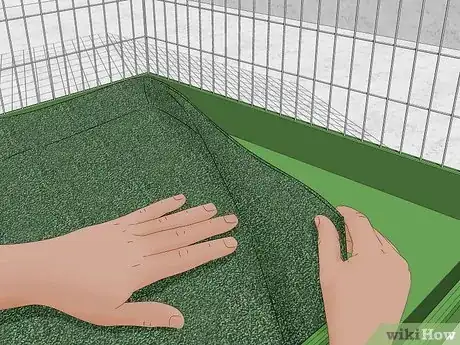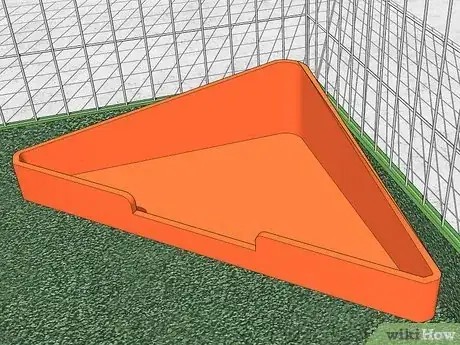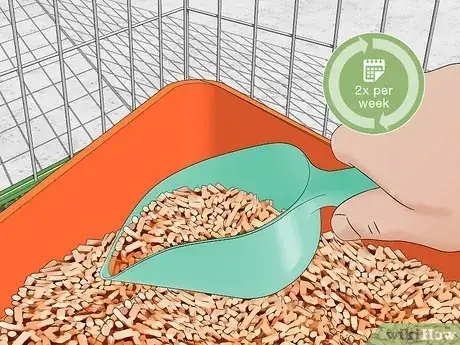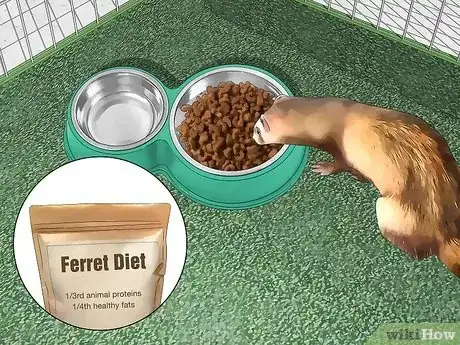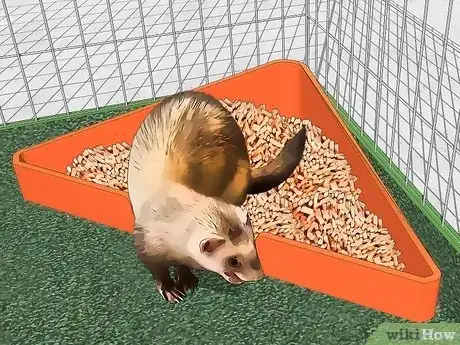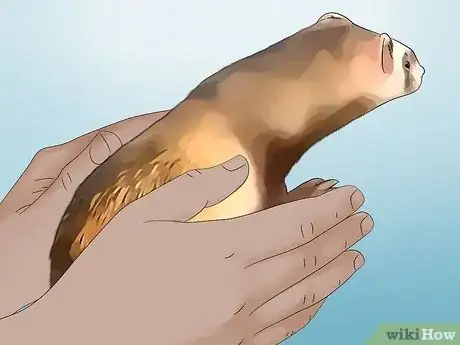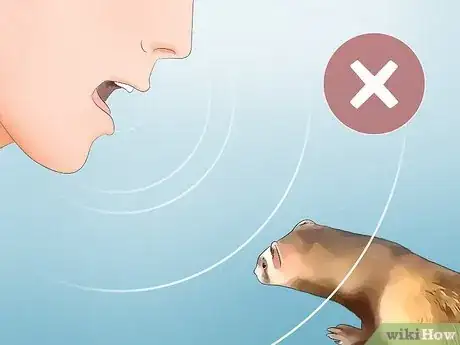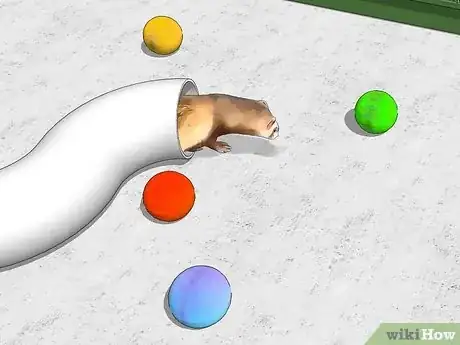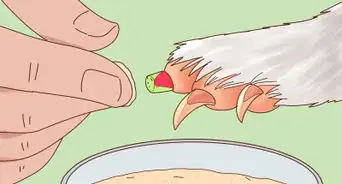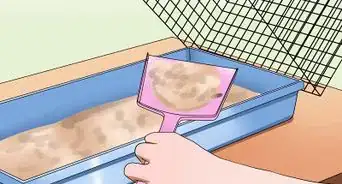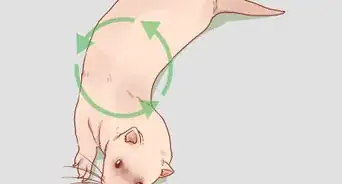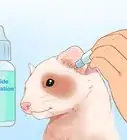This article was co-authored by Melissa Nelson, DVM, PhD. Dr. Nelson is a Veterinarian who specializes in Companion and Large Animal Medicine in Minnesota, where she has over 18 years of experience as a veterinarian in a rural clinic. She received her Doctor of Veterinary Medicine from the University of Minnesota in 1998.
There are 8 references cited in this article, which can be found at the bottom of the page.
wikiHow marks an article as reader-approved once it receives enough positive feedback. This article received 33 testimonials and 100% of readers who voted found it helpful, earning it our reader-approved status.
This article has been viewed 193,567 times.
Ferrets are popular pets due to their friendly and outgoing personalities. Curious by nature, a ferret can provide hours of entertainment for their owner. However, they require a great deal of care and attention. To keep a ferret as a pet, you’ll need to create a proper cage environment with a litter box, food and water bowls, and toys. Also, taking your ferret to the vet on a yearly basis will ensure that it stays both healthy and happy.
Steps
Creating a Clean and Comfortable Environment
-
1Select a cage that is at least 18” x 18” x 30.” This is enough room for a single ferret. If you get another one, then you’ll need a slightly larger cage. A wire cage works the best, as ferrets have a tendency to chew through wooden bars. Some cages are bi-level and come with specialty ramps and spots to attach a hammock.[1]
- Don’t keep your ferret in an aquarium. The solid sides prevent the flow of air and makes it a poor habitat for ferrets.
- Make sure that any cage that you select has a solid, secure latch. Ferrets are accomplished escape artists and can lift latches unless they are complex.
-
2Line the floor of the cage with carpet. Walking on a wire floor can irritate your ferret’s feet over time and even cause sores to develop. Cut down a piece of washable carpet to fit on the bottom of the cage. This will give your ferret a soft cage surface. If the carpet gets dirty, simply pull it out and wash it.[2]
- Linoleum tiles are another cage flooring option. Cut them down to size as you would with carpet.
- After you install the carpet, watch your ferret for a few days to ensure that it doesn’t try to chew on the fibers. If this happens, replace the carpet with tiles.
Advertisement -
3Put a litter box into the cage. Look for a cardboard or plastic litter pan. It should be about 3 to 5 inches (7.6 to 12.7 cm) in height. Some litter pans come with small latches that you can use to attach it to the side of the cage. Ideally, place the box in a spot away from your ferret’s eating area.
- Fill the box with about 1 inch (2.5 cm) of paper or plant pellets. These are available at your local pet store. The dust from regular litter can irritate your ferret’s lungs.
-
4Clean your ferret’s cage at least twice each week. Use a scooper to remove any soiled litter from the box. Pull out the cage carpet and wash it on a warm setting. Take out any hammocks or bedding and wash them as well. Wipe down any toys and the cage bars with a natural cleaner.
- You can make a safe, natural cleaning solution by adding some lemon juice or vinegar to water.
Feeding Your Ferret
-
1Obtain suitable feeding containers. You will need 2 bowls (preferably stainless steel or ceramic) : 1 for food and 1 for water. Each dish should hold at least 8 ounces of food or water. Pet stores sell dishes that can be attached to the side of the cage to minimize spills. It’s also a good idea to install a water bottle that hangs from an interior wall of the cage.[3]
- Wash the bowls and bottle with warm water and dish soap or run them through the dishwasher on a weekly basis. This will help to keep algae from developing.
-
2Give your ferret a diet with both animal proteins and fats. An ideal ferret diet will contain about 1/3rd or more animal proteins and about 1/4th healthy fats. Look for a quality dry ferret food that contains ingredients at these levels. You can also talk with your vet about using high-quality kitten food as well.[4]
- Ferrets enjoy small, cut-up snacks of cooked turkey, cooked egg, or chicken meat.
- Avoid giving your ferret fresh fruits or vegetables. The sugars in fruits can irritate your ferret’s digestive system. And, ferrets have been known to choke on raw vegetables.
- Keep in mind that ferrets need to eat about 8 to 10 times per day because they process food so quickly.[5]
-
3Provide fresh water every day. Fill up your ferret's water bowl and bottle with room temperature water each day. If the water is too cold, then your ferret will stop drinking and could risk dehydration.
- To tell whether your ferret is dehydrated, pinch the skin on its scruff (the back of its neck) gently, pull up, and let go. If it snaps back, like the skin of the back of your hand does, then your ferret is healthy. If the skin takes a while to flatten or sticks up straight, take your ferret to a vet for possible dehydration.
Maintaining Your Ferret’s Mental and Physical Health
-
1Take your ferret for annual vet visits. Like most other animals, ferrets need to be checked out by a vet at least yearly. At these visits your vet will do a general physical check-up of your ferret. They will also ask you if your ferret has been suffering from any health or behavioral problems.[6]
- Your vet will keep your ferret on a standard vaccination schedule, including yearly rabies shots. Many jurisdictions require these shots for domestic pets.
-
2Train your ferret to use the litter box. Watch to see where your ferret goes to the restroom when in the cage. Place the litter box in this same location. Then, put a few fresh droppings into the box, so that it smells like a restroom for your ferret. Most ferrets will quickly start using the box.[7]
- If your ferret refuses to use the box, then experiment with changing out the litter to another type of plant fiber.
-
3Hold your ferret with 2 hands at all times. Ferrets might seem like sturdy little creatures, but they are actually quite fragile. When you pick up or hold your ferret, place 1 hand underneath its chest and use another to cup its hindquarters. Don’t ever grab your ferret by its tail.[8]
- You can also keep your ferret secure by using 1 hand to hold its hindquarters, while using your other hand to gently grasp the scruff behind your ferret’s neck.
-
4Speak in low, soft tones to your ferret. Because of their acute sense of hearing, you are likely to cause your ferret to panic if you raise your voice. This can make them wiggle, or even try to bite you, if they are being held. Instead, make a habit of using a calm, soothing voice when interacting with your ferret. This is a great way to build trust.[9]
-
5Give your ferret time outside of its cage. When ferrets are awake, they are extremely curious and interested in their surroundings. Let your ferret roam around a ferret-proofed room or space for at least a few hours each day. Make sure that you supervise this time, just in case your ferret gets into trouble.[10]
- To make a space safe for your ferret, check for any holes or gaps where it might hide or get stuck. Remove any medications or other substances which could poison your ferret. Put away small items, such as remotes, which (if broken) could constitute a choking hazard.[11]
-
6Provide a variety of hard plastic toys both inside and outside the cage. Ferrets can chew through rubber or fabric toys quite easily. Whiffle golf balls, baby rattles, or even Nylabones are safer options that last longer. Put 2-3 toys in your ferret’s cage and have a few available in any play spaces as well.
- Inspect each toy every week and replace any that are torn or otherwise damaged.
- Wipe down toys with a clean wet rag about once per week as well.
-
7Play with your ferret for a minimum of 30 minutes each day. Ferrets are highly intelligent and thrive on human contact. Playing with your ferret can be as simple as gently rolling a few plastic balls in front of it. Or, you can get more elaborate and teach your ferret to come when called, roll over, or even fetch.[12]
- The key to teaching tricks to your ferret is repetition. Repeat the same request over and over again, providing treats, such as cooked chicken pieces, when your ferret gets it right.
-
8Monitor all interactions with children and other pets. Most ferrets have a friendly personality, but they can bite if they feel threatened or if they believe that you are offering them food. For those reasons, it’s best if you hold the ferret when children are around. It’s also a good idea to limit the interactions between ferrets and other family pets, such as cats or dogs.
- Because ferrets have such fragile bones, even a small dog can easily cause them injury.
-
9Bathe your ferret once every 6 months or annually. You can also wait to bathe your ferret until it is dirty due to a spill or illness. Bathing your ferret too often can dry out its skin and prompt over-activated stink glands, which can cause even more ferret smell.
- Use ferret shampoo, which can be found at a pet store.
- Your ferret's coat is important to its health. If its coat is soft, full and doesn't have an unusually smelly odor, then your ferret is healthy.
Expert Q&A
-
QuestionCan a small dog be around a ferret and not eat/kill it ?
 Melissa Nelson, DVM, PhDDr. Nelson is a Veterinarian who specializes in Companion and Large Animal Medicine in Minnesota, where she has over 18 years of experience as a veterinarian in a rural clinic. She received her Doctor of Veterinary Medicine from the University of Minnesota in 1998.
Melissa Nelson, DVM, PhDDr. Nelson is a Veterinarian who specializes in Companion and Large Animal Medicine in Minnesota, where she has over 18 years of experience as a veterinarian in a rural clinic. She received her Doctor of Veterinary Medicine from the University of Minnesota in 1998.
Veterinarian It really depends on the dog's nature. Terrier type dogs may want to bite a ferret.
It really depends on the dog's nature. Terrier type dogs may want to bite a ferret. -
QuestionCan I take my ferret out to play when my dog is around?
 Melissa Nelson, DVM, PhDDr. Nelson is a Veterinarian who specializes in Companion and Large Animal Medicine in Minnesota, where she has over 18 years of experience as a veterinarian in a rural clinic. She received her Doctor of Veterinary Medicine from the University of Minnesota in 1998.
Melissa Nelson, DVM, PhDDr. Nelson is a Veterinarian who specializes in Companion and Large Animal Medicine in Minnesota, where she has over 18 years of experience as a veterinarian in a rural clinic. She received her Doctor of Veterinary Medicine from the University of Minnesota in 1998.
Veterinarian Yes, as long as your dog is gentle and not highly prey driven. Just make sure to monitor them carefully when they are out together.
Yes, as long as your dog is gentle and not highly prey driven. Just make sure to monitor them carefully when they are out together.
Warnings
- Wash your hands with soap and water after handling your ferret. It’s possible to spread some illnesses between you and your ferret.[13]⧼thumbs_response⧽
Things You'll Need
- Large ferret cage
- Hammock, sleeping bag or other bed
- Cage liner material
- Ferret food
- Non-spill food dish
- Water bottle or non-spill dish
- Litter
- Litter box
- Litter scooper
- Ferret shampoo
- Hard plastic toys
References
- ↑ http://www.humanesociety.org/animals/ferrets/tips/ferret_housing.html?credit=web_id139808899
- ↑ http://www.humanesociety.org/animals/ferrets/tips/ferret_housing.html?credit=web_id139808899
- ↑ https://www.petcha.com/fresh-water-for-a-healthy-ferret/
- ↑ http://www.humanesociety.org/animals/ferrets/tips/ferret_feeding.html?credit=web_id139808899
- ↑ https://www.petmd.com/ferret/nutrition/evr_ft_nutrition_ferret
- ↑ http://www.humanesociety.org/animals/ferrets/tips/ferrets_as_pets.html?credit=web_id139808899
- ↑ http://www.humanesociety.org/animals/ferrets/tips/ferrets_as_pets.html?credit=web_id139808899
- ↑ http://www.humanesociety.org/animals/ferrets/tips/ferrets_as_pets.html?credit=web_id139808899
- ↑ http://www.humanesociety.org/animals/ferrets/tips/ferrets_as_pets.html?credit=web_id139808899
About This Article
To care for a ferret, feed it quality dry ferret food that contains both animal proteins and fats and provide plenty of fresh water daily. Next, remember to speak to your ferret in a soft, calm voice and let your pet have a few hours outside of its cage every day. It's also important to play with your ferret for 30 minutes every day and give it 2-3 toys to play with when you're not around. Don't forget to bathe your ferret 1-2 times annually! For tips on creating a proper cage environment, read on!

